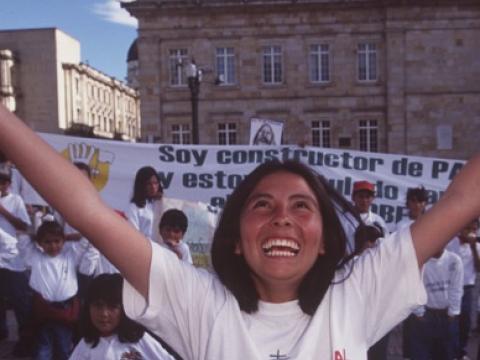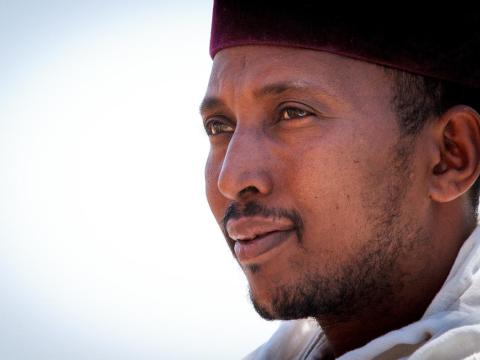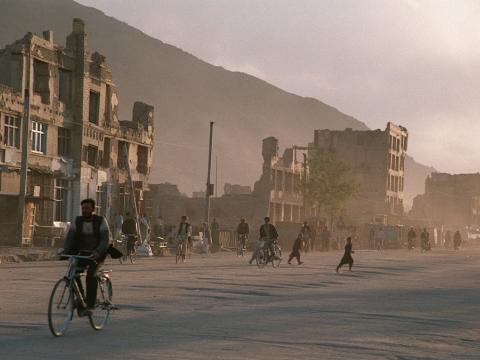
Finding a place for peace in the HDP nexus
Juliette Semaan observes that peacebuilding is often an add-on to other programming, and suggests future ways to mitigate that challenge.
30 May, 2024
I grew up in Lebanon, a country constantly impacted by multiple intersectoral conflicts dating back to my parents’ childhoods. I heard how it affected their lives, and I myself witnessed war's impact on the lives of everyone in Lebanon. As a humanitarian professional I have also seen how conflict hits vulnerable communities the hardest. It exacerbates existing problems, and leaves very little buffer to cope with the hardships.
While I remain baffled by the seeming inevitability of conflict, I also fundamentally believe in the potential for and desperate need for peace.
More than just an add-on
Prior to joining World Vision's Global Hunger Response (GHR) as programme officer, the team had contributed to a discussion paper led by the European Peacebuilding Liaison Office (EPLO) on optimising integration of the peace component in the humanitarian-development-peace (HDP) nexus. It explains how we must pave the way for a holistic and sustainable approach that advances humanitarian and development outcomes. When I had an opportunity to join a webinar presenting this paper, I jumped at the chance to meet peace actors and learn about some best practices that I could apply to our work in my new role with GHR.
During our discussion, an important point was raised: that the HDP nexus’ peace element was often overlooked due to divergent views on how to best define it. It reminded me of my own experiences in the field, where peacebuilding initiatives were often treated as add-ons. They were optional and not a central element. This fragmented approach not only fails to address root causes of conflict in vulnerable communities, but it also undermines the effectiveness of our humanitarian and development interventions.
It's time we acknowledged that peace isn't just the domain of specialists—it's a collective endeavour that demands integration at every stage of planning and execution.
After the call, it became clear how pivotal it was to organically weave peace into our initiatives.
More needed to be done
When reflecting on GHR’s previous Phase I approach, which ended in September 2023, the response rallied resources, surpassed targets, and served millions of the world’s most vulnerable. Yet, beneath these amazing achievements lay a nagging feeling—we were just scratching the surface. For our efforts to truly resonate, we needed a more holistic approach; one that not only responds to crises but also nurtures community resilience. This is one of the reasons why we committed to aligning GHR’s Phase II across the HDP nexus and scaled up our work to provide integrated solutions that more effectively address the global hunger crisis.
The significance of prioritising peace in our work cannot be overstated. The 2024 Global Report on Food Crises reaffirms that conflict is a primary driver of hunger and a formidable obstacle to achieving sustainable development goals. By focusing interventions on conflict prevention and peacebuilding, we can better help the most vulnerable while laying the groundwork for long-term stability.
More ideas for prioritising peace
Are you looking to prioritise the peace element of the HDP nexus in your work? Consider these tips from the EPLO discussion paper and some examples from my time in the field:
-
Consider peace as a full and essential component of the HDP nexus.
It should be given equal focus while designing interventions and advocating for funding.
-
Conduct a gender-responsive conflict analysis prior to designing any project.
This will help us determine the root causes and drivers of conflict and exclusion. It will also ensure that our interventions are conflict-sensitive and do no harm to the community while contributing to peace by avoiding violence or exclusion whenever possible.
During my work in Lebanon, we integrated conflict sensitivity into our WFP livelihoods project. Through the conflict analysis, we found out that that there has been increasing conflict between herders and farmers mainly due to herders accessing farmers’ land seeking water. We created watering points for herders while also working with farmers on climate-smart agriculture techniques to improve their yield. Through these development interventions, we contributed to peace between the two communities.
-
Train field staff to diffuse tension.
Staff training on communication skills and dealing with conflict helped to diffuse tensions that arose between Syrian refugees and their Lebanese host communities, according to International Alert in Lebanon.
- Form inclusive, representative advisory boards with members from the affected communities.
After a flood destroyed WASH infrastructures in South Sudan’s Upper Nile State, which increased food insecurity and led to violent conflict over available resources, Nonviolent Peaceforce and their partners shaped inclusive and representative advisory boards. These provided the needed space for voices from each of the affected communities, ensuring all could be heard, and allowing collaboration towards a sustainable peace.
Integrating peace into our humanitarian and development endeavours isn't only a moral imperative—it's a strategic necessity. As we navigate the intricate tapestry of complex global challenges, let us remain steadfast in our commitment to building a more peaceful, equitable world –one vulnerable community at a time.
Juliette Semaan is a Programme Officer for World Vision’s Global Hunger Response. She oversees work including programming, reporting, fundraising and more. She is based in Lebanon.


